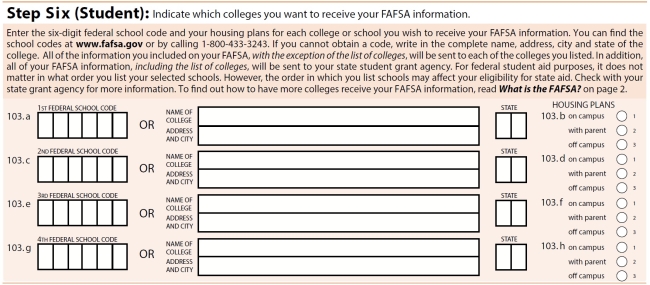You have /5 articles left.
Sign up for a free account or log in.

2016-17 FAFSA / U.S. Department of Education
The U.S. Department of Education is planning to further restrict how it shares information about students’ college preferences, but some state officials are concerned the changes will make it more difficult for them to award funds from state financial aid programs.
The department has already stopped providing colleges with the entire list of institutions that students express interest in attending when filling out the Free Application for Federal Student Aid, known as the FAFSA. That new policy, which took effect Jan. 1, was a response to concerns that students may have been disadvantaged by colleges knowing the other colleges to which a student was also applying (and where those institutions ranked on the student’s list.)
State agencies that award financial aid, however, continue to have access to the full list of colleges a student provides on the FAFSA, including the ordering of those institutions. But the Education Department now plans to change that, a department official confirmed in an email to Inside Higher Ed.
Starting on the FAFSA for the 2017-18 academic year, the department will stop providing state agencies with the order in which students list colleges, the official said. States will continue to receive the full list of colleges that students share on the application, but the Education Department will first randomize the ordering of the institutions.
State officials have found that students are most likely to attend the college they list first on the FAFSA. Many state agencies use that information to plan how much state financial aid money they expect to dole out. And others use the information to start packaging state financial aid awards.
The Education Department has previously acknowledged that states use the FAFSA lists for such purposes. The current FAFSA, for instance, warns students that “the order in which you list schools may affect your eligibility for state aid.”
Without access to the list of colleges students provide on the FAFSA, in the order listed by the student, state officials say they will be left in the dark about which students are planning to enroll at colleges for which they may be eligible for state aid.
The National Association of State Student Grant and Aid Programs sent a letter to the Obama administration last year urging officials to reconsider their plans.
“No longer providing states with the schools listed, or no longer providing the schools in the order listed by the student, is anticipated to have costly and confusing impacts to both states and students,” the group wrote (italics from the original).
In Pennsylvania, for instance, about 80 percent of state grant recipients attend their first-listed institution on the FAFSA, according to Keith New, a spokesman for the Pennsylvania Higher Education Assistance Agency, known as PHEAA, which administers the program. For those students, PHEAA automatically calculates their state award -- which ranges between roughly $100 and $4,000 -- after receiving the information from the FAFSA.
New said if the Education Department curtails PHEAA's access to students’ FAFSA list information, the agency would have to reach out to about 130,000 state college or university applicants rather than automatically calculating their awards.
“The burden will be placed on the students to provide the name of their school to us a second time. It's certainly going to be a big communications issue and it would add complexity,” Keith said. “The potential is significant for students, especially those who may already be at risk, to fall through the cracks.”
Similarly, Tennessee officials said the department’s plan to randomize the FAFSA list would complicate how they dole out state awards, including the popular Tennessee Promise program, which allows students to attend community college without paying tuition.
Tim Phelps, associate executive director of the Tennessee Student Assistance Commission, said the state typically packages an award to the first institution that is eligible for state aid that a student provides on his or her FAFSA list.
Without access to the complete FAFSA list information, he said, the commission would have to wait until students directly provide them with the name of the colleges for which they are seeking state aid.
“It’s adding another barrier that students would have to cross, in order to continue to be eligible or to become eligible,” Phelps said of the department’s plan.
The department’s initial move to curtail colleges’ access to the FAFSA list was announced last August after concerns that some colleges were using the lists of colleges students provide on the FAFSA in ways that could harm students’ admissions or financial aid prospects.
“We had learned, from a number of places, that some schools -- not most but more than we would like -- use those data for purposes totally inappropriate, and in some cases, unlawful,” Jeff Baker, a department official, said at a federal financial aid conference last month. Inside Higher Ed reported in 2013 that some colleges were denying admission and possibly reducing financial aid to students based on the FAFSA information the department was sharing with colleges.
But state officials contend that their use of the FAFSA college list, by contrast, benefits students by streamlining the process for students to apply for state-based loans and grants.
“It tries to solve a problem that doesn’t exist,” said Phelps of the Tennessee aid agency. “It really muddies the water for our programs.”
The FAFSA for the 2017-18 school year, for which these changes would take effect, will be published and available starting this Oct. 1 under the Obama administration’s new, earlier timeline for federal financial aid.




